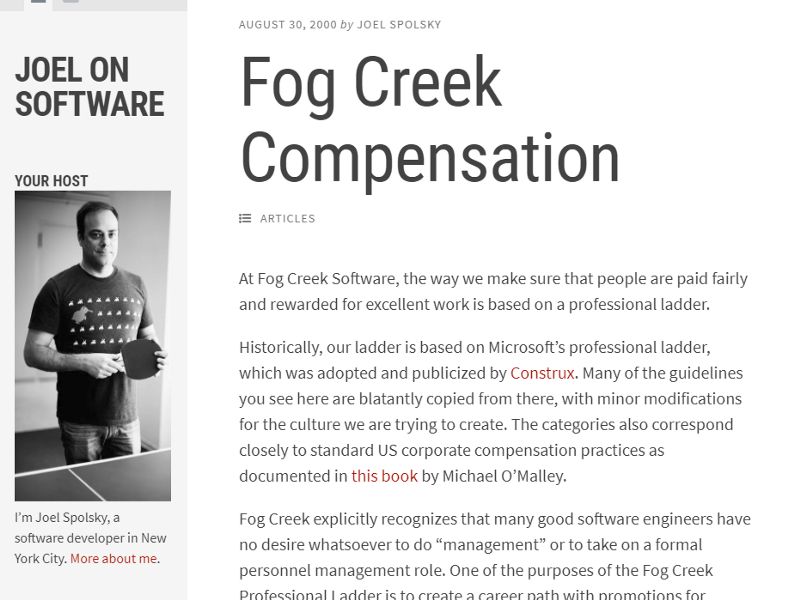Talking Transparency at Fog Creek
How much money do you earn?
Decades ago, discussions about salaries and compensation in the workplace were seen as taboo. But now, more and more companies are being open and transparent about these topics, particularly in the tech industry.
Here at Fog Creek Software, salary transparency has been part of our evolution as a company since the very beginning.
“In the interest of fairness, Fog Creek’s compensation policy is open, public, simple, and accountable,” says founder Joel Spolsky in a blog post from August 2000.
According to Spolsky, some companies consider revealing your salary a fireable offense. “We feel that in the long run, this can only hurt us through negative morale, high turnover, and destructive office politics.”

Anil Dash, current CEO of Fog Creek remembers when he first read Joel’s thoughts on compensation.
“Like a lot of people in tech, at that time I hadn’t studied much about workers’ rights or the history of labor, so I didn’t know what a great role predictable compensation paid in making work more fair. Joel being Joel, he couched it in the context that many coders like rational, predictable systems, which is also often true! And I think from both standpoints it was about making workers happy and reducing some of the stress and tension around compensation and salaries, which are some of the most fraught conversations anyone can have at work.”
As companies grow and change over the years, so do their policies. Fog Creek is no exception here, and implementing salary transparency over the years has been a continual process. Jessica Moy, Head of People and Culture at Fog Creek Software, cites the general discussion and changes in tech workplace culture over the past few years as a reason for keeping salary transparency top of mind.
“A huge topic in the workplace in general is why don’t we know what other people make, why it’s a bad thing, and how [salary transparency] can help, especially when we’re thinking about the general wage gap between minorities, women, and other underrepresented groups. With that in mind, Fog Creek wanted to really embrace diversity and inclusion, and realized that a really key part of that was to make salary transparency a priority. It’s definitely all related.”
“As the company grew,” notes Dash, “new roles were added that didn’t neatly fit into the technical orientation of Joel’s original salary ladder. We added Sales people who expected standard compensation based on their sales volume, and administrative or organizational roles that weren’t going to be advancing in programming skills the way that coders would. As these new roles expanded, salary transparency sort of got left behind, to the point where half the company didn’t have a ladder to look at.”
We knew that these differences between roles weren’t good enough.
“Fog Creek has always been at the forefront of pushing what workplaces can and can’t be,” adds Moy. And if that is to continue, we had to do better.
According to Dash, prioritizing this level of transparency connected to an internal ethos we have at Fog Creek about empowering our employees too.
“We talk a lot about how everybody at the company should spend the company’s money as if it were their own. To do that right, we have to give everybody enough information to know what our people cost. Finally, it put it in solid ground as we emphasized improving on inclusion in our hiring and promotions, so we could confidently tell candidates of all backgrounds that they were treated fairly.”
Fog Creek’s current culture around transparency didn’t come without some challenges.
“The tricky thing about having a 17-year-old company embrace salary transparency again is that a lot of the people that started at Fog Creek during this time didn’t intend to share their salaries when they accepted the job,” Moy mentions.
“We ended up using some industry databases to compare salaries and make sure we were being fair, but that didn’t quite give the team internal visibility or predictability into compensation,” adds Dash. “We did an internal audit and found we were competitive to companies our size and fair in terms of pay by gender or other factors, but people couldn’t tell that was the case. It was the worst of both worlds — the company was doing the right thing, but employees didn’t know, and employees wanted visibility but because it wasn’t there it seemed like the company was reluctant even though it wasn’t.”
As you can see, adding transparency to an existing company is not an easy feat. Dash mentions that our sibling company Stack Overflow was a great model of openness with their salary calculator and by sharing salary data gathered from their annual developer survey. Startups like Buffer have been at the forefront of radical transparency since their early days. Later in the week, we’ll speak with Courtney Seiter, Buffer’s Director of People, and gain more insight on how they have handled transparency throughout the years.
“Ultimately, not many companies are doing this yet. That’s why we think it’s a competitive advantage for attracting and retaining great people.”
Moy agrees, “it’s really important that we practice what we preach.”

